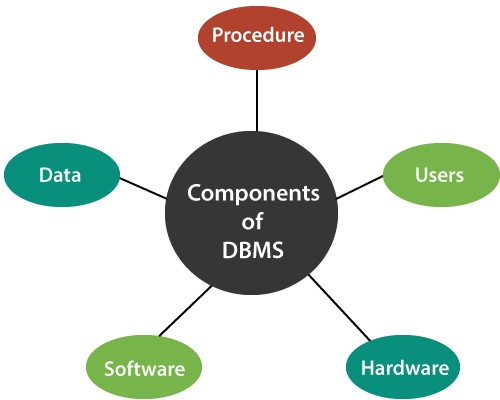Components of DBMS
Components of DBMS: There are the following components of DBMS:
- Software
- Hardware
- Procedures
- Data
- Users

Software
- The main component of a Database management system is the software. It is the set of programs which is used to manage the database and to control the overall computerized database.
- The DBMS software provides an easy-to-use interface to store, retrieve, and update data in the database.
- This software component is capable of understanding the Database Access Language and converts it into actual database commands to execute or run them on the database.
Hardware
- This component of DBMS consists of a set of physical electronic devices such as computers, I/O channels, storage devices, etc that create an interface between computers and the users.
- This DBMS component is used for keeping and storing the data in the database.
Procedures
- Procedures refer to general rules and instructions that help to design the database and to use a database management system.
- Procedures are used to setup and install a new database management system (DBMS), to login and logout of DBMS software, to manage DBMS or application programs, to take backup of the database, and to change the structure of the database, etc.
Data
- It is the most important component of the database management system.
- The main task of DBMS is to process the data. Here, databases are defined, constructed, and then data is stored, retrieved, and updated to and from the databases.
- The database contains both the metadata (description about data or data about data) and the actual (or operational) data.
Users
- The users are the people who control and manage the databases and perform different types of operations on the databases in the database management system.
There are three types of user who play different roles in DBMS:
- Application Programmers
- Database Administrators
- End-Users
- Application Programmers
The users who write the application programs in programming languages (such as Java, C++, or Visual Basic) to interact with databases are called Application Programmer.
2. Database Administrators (DBA)
A person who manages the overall DBMS is called a database administrator or simply DBA.
3. End-Users
The end-users are those who interact with the database management system to perform different operations by using the different database commands such as insert, update, retrieve, and delete on the data, etc.
Related Posts:
- DBMS Data Independence: Logical and Physical
- Hashing in DBMS: Static and Dynamic
- Deadlock in DBMS
- Conflict Serializability in DBMS
- Concurrent Execution of Transaction
- Normalization in DBMS: 1NF, 2NF, 3NF, BCNF & 4NF with Examples
- DBMS Joins: Inner, Outer, Natural and Self Join
- Conversion of ER Diagram into Relational Model
- Difference between DBMS and RDBMS
- DBMS Keys: Primary, Super, Candidate, Foreign